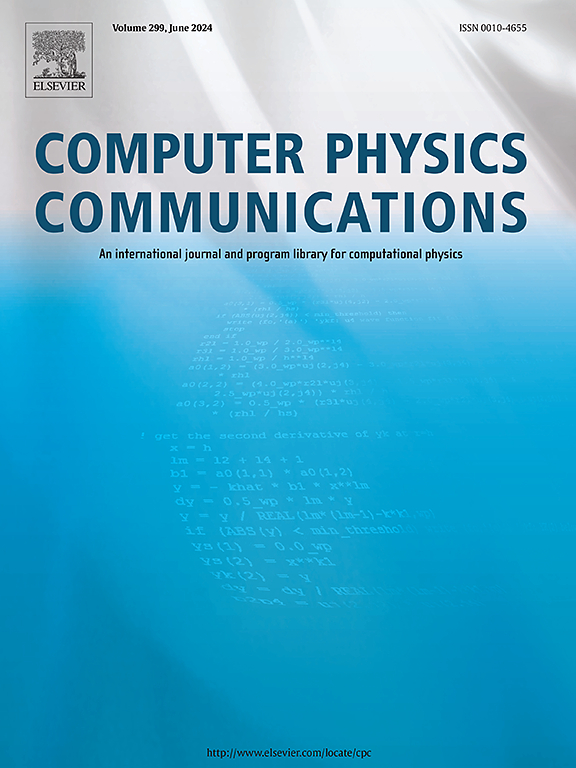各向异性磁化等离子体的辛时域有限差分(p,q)法与矩阵指数法相结合的数值研究
IF 7.2
2区 物理与天体物理
Q1 COMPUTER SCIENCE, INTERDISCIPLINARY APPLICATIONS
引用次数: 0
摘要
将矩阵指数法(ME)与辛时域有限差分法(ME- sfdtd (p,q))相结合,提出了一种模拟各向异性磁化等离子体介质电磁特性的新算法。SFDTD(p,q)方法在时域实现了p阶精度,在空域实现了q阶精度,为麦克斯韦方程组和电流密度方程的数值离散化提供了基础。在此基础上,对控制方程进行多阶段辛积分得到的矩阵指数系数项进行了精确求解。这使得ME-SFDTD(p,q)方法成功建立了统一的数值框架,能够计算各向异性磁化等离子体区域的场分量。同时,在采用高阶空间差分近似时,引入了一种有效的子网格技术来管理空气-等离子体界面。在此之后,对所提出的方法的数值特性进行了深入的分析,包括色散、稳定性和计算复杂性。此外,利用两个数值算例考察了不同微分策略下ME-SFDTD(p,q)方法的计算特性。最后,对计算精度、效率和内存使用的综合评估表明,ME-SFDTD(4,4)方法有效地协调了这些因素之间的权衡,使其成为精确模拟各向异性磁化等离子体的可行数值求解器。本文章由计算机程序翻译,如有差异,请以英文原文为准。
A numerical study of the symplectic FDTD(p,q) method combined with matrix exponential technique for anisotropic magnetized plasma
A novel algorithm has been developed to simulate the electromagnetic properties of anisotropic magnetized plasma media, integrating the matrix exponential (ME) approach with the symplectic finite-difference time-domain (ME-SFDTD(p,q)) method. The SFDTD(p,q) method achieves p-th order accuracy in the temporal domain and q-th order accuracy in the spatial domain, providing a foundational numerical discretization of Maxwell's equations and the current density equation. Subsequently, the ME method is employed to accurately solve the matrix exponential coefficient terms that arise from the multi-stage symplectic integration of the governing equations. This leads to the successful establishment of a unified numerical framework for the ME-SFDTD(p,q) method, capable of computing the field components in anisotropic magnetized plasma regions. In parallel, an efficient sub-grid technique is introduced to manage the air-plasma interface when employing a high-order spatial difference approximation. Following this, a thorough analysis of the numerical characteristics of the proposed method, including dispersion, stability, and computational complexity, is conducted. Additionally, two numerical examples are utilized to examine the computational characteristics of the ME-SFDTD(p,q) method under different differential strategies. Finally, a comprehensive assessment of computational accuracy, efficiency, and memory usage observes that the ME-SFDTD(4,4) method effectively reconciles the trade-off between these factors, establishing itself as a viable numerical solver for the accurate simulation of anisotropic magnetized plasmas.
求助全文
通过发布文献求助,成功后即可免费获取论文全文。
去求助
来源期刊

Computer Physics Communications
物理-计算机:跨学科应用
CiteScore
12.10
自引率
3.20%
发文量
287
审稿时长
5.3 months
期刊介绍:
The focus of CPC is on contemporary computational methods and techniques and their implementation, the effectiveness of which will normally be evidenced by the author(s) within the context of a substantive problem in physics. Within this setting CPC publishes two types of paper.
Computer Programs in Physics (CPiP)
These papers describe significant computer programs to be archived in the CPC Program Library which is held in the Mendeley Data repository. The submitted software must be covered by an approved open source licence. Papers and associated computer programs that address a problem of contemporary interest in physics that cannot be solved by current software are particularly encouraged.
Computational Physics Papers (CP)
These are research papers in, but are not limited to, the following themes across computational physics and related disciplines.
mathematical and numerical methods and algorithms;
computational models including those associated with the design, control and analysis of experiments; and
algebraic computation.
Each will normally include software implementation and performance details. The software implementation should, ideally, be available via GitHub, Zenodo or an institutional repository.In addition, research papers on the impact of advanced computer architecture and special purpose computers on computing in the physical sciences and software topics related to, and of importance in, the physical sciences may be considered.
 求助内容:
求助内容: 应助结果提醒方式:
应助结果提醒方式:


